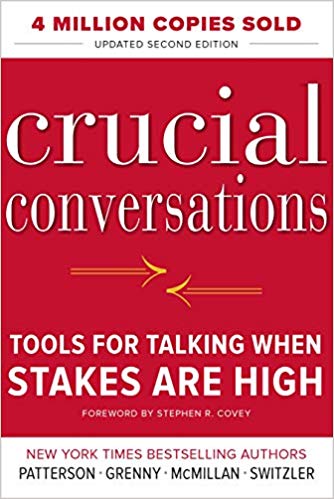

This article is an excerpt from the Shortform summary of "Crucial Conversations" by Kerry Patterson. Shortform has the world's best summaries of books you should be reading.
Like this article? Sign up for a free trial here .
What are common communication problems? How do you know if you have any of these communication issues, and how do you fix them?
According to Crucial Conversations, there are many common communication problems that could be holding you back. Learn about common communication issues below, and how to solve them.
Common Communication Problems
There are many common communication problems that people encounter. You can have communication issues at work, or in your personal life, but often, these issues have similar sources. Here are fix common communication problems and how to fix them.
1. The Fool’s Choice
One of the biggest communication problems is the fool’s choice. Often when our adrenaline starts pumping, our brain function stalls and we feel forced to choose between only two bad alternatives. But this either/or belief gets us sidetracked and can kill dialogue.
For example, when a group of teachers met to discuss curriculum changes, one of them — an older, experienced teacher — digressed from the topic and rambled to the point that a younger teacher became frustrated and interrupted him rudely and offensively. The younger teacher made a fool’s choice — he was disrespectful because he thought his only choices were rudeness or not speaking up, thus allowing the unproductive conversation to continue.
But instead of focusing on only those two options, the young teacher should have set aside his emotions and asked himself what he wanted for himself and the relationship. He could have maintained his relationship with his older colleague, while also speaking up in a respectful way — helping the older man to clarify and focus his points, to add his meaning to the shared pool.
When you refuse the fool’s choice at an emotional time, and return to the question of what you really want, your brain responds with better options. You can share your concerns, listen to others’ concerns, and build your relationship at the same time. You can resolve many communication issues by doing this.
2. Your Style Under Stress
Another one of the most common communication problems is that people respond differently under stress. The most difficult thing to watch for as you’re dual-processing is your own behavior. Paying attention to your behavior takes a back seat — it’s hard to pull away from the lure of an argument, plus you have to be alert to others’ tactics.
However, you need to become a vigilant self-monitor — pay close attention to what you’re doing and the impact it’s having, then alter your strategy if necessary. Watch specifically to see whether you’re having a good or bad impact on safety. (Many people toggle between holding back and being too forceful).
To increase your self-awareness, think about what you do when conversations become difficult. When you understand your style under stress, you can find ways to improve your effectiveness in crucial conversations.
Your Stress Test
Here’s a quiz to see how you respond under pressure (using defensive tactics or dialogue skills). To answer the questions, pick a relationship (at work or home), and consider each statement in that context. Then consider which of the following behaviors/tactics you’re most inclined to use, and see if it causes common communication problems.
Withdrawing
- When others become aggressive in conversations, I clam up.
- I hold back rather than speaking candidly or giving my full opinion.
Masking (understating or selectively showing your true opinions using sarcasm, sugarcoating, and couching)
- Rather than say what I think when I’m frustrated, I may use jokes or sarcastic remarks.
- When I have something critical to say, I try extra hard to soften the blow
Avoiding (steering away from sensitive topics)
- I try to change the subject when people bring up something awkward.
- I try to stay away from people I’m having trouble with.
Controlling: (hyperbole, absolutes, changing subjects, directive questions)
- When discussing a topic that’s very important to me, I sharply counter every opposing view.
- I might cut people off or change the subject to return to what I want to talk about.
Labeling (attaching a label in order to stereotype or dismiss someone or their idea)
- When others make points that I think are stupid, I say so.
- Sometimes I can’t help myself when I’m stunned by a comment, and I say things like, “Give me a break!” or “Are you serious?”
Attacking (making the other person suffer)
- In a heated discussion, I can be tough on the other person; they may end up feeling I insulted them.
- When the discussion gets heated, I have started saying things to hurt them personally, rather than discussing their points.
Ensuring safety
- When things get tense, I try to find out why people are upset.
- When others misunderstand me and get defensive, I quickly clarify what I mean by using contrasting (what I don’t and do mean).
Exploring others’ paths
- When others hesitate to share their views, I listen more intently.
- After I share strong opinions, I urge others to share opposing views.
Controlling your emotions
- When others misunderstand me and get defensive, I clarify what I mean by using contrasting (what I don’t and do mean).
- When I get upset about something and start blaming others, I stop and ask myself how I contributed to the situation.
3. When It’s Hard to Respect Someone
Communicating with someone you don’t respect can lead to some of the biggest communication problems. It can be difficult to respect (or share a purpose) with people whose values and morals differ completely from yours, or with someone who is self-centered or has dubious motives.
But you don’t have to share every objective or respect every aspect of another person’s character before you can talk. This leads to common communication problems. Try this:
- Respect the other person as a human being.
- Focus on ways you’re similar rather than different.
- Without excusing others’ behavior, empathize. When you remember that everyone has weaknesses it’s easier to respect others.
When you do these things, you can feel a connection or mutuality and you can talk with the most difficult people.
4. When You Go Overboard
Problems in communication can arise when you get into trouble by pushing your point of view too hard. It gets heated and you feel you have to win. Others resist, argue, or retreat into silence, so you push harder. In the end, no one is listening, and nothing is added to the pool of information.
Here’s how things go wrong.
- You feel you’re right. When you push your ideas on others, it’s generally because you feel you’re right and they’re wrong. You feel there’s no need to expand the pool of information because you have the answer.
- You feel justified in using verbal tricks. You stack the deck with supporting information, leaving out any contrary information; or you exaggerate or use inflammatory language. But the more forceful you become, the more resistance you generate.
How To Change
Believing you’re right is one of the biggest communication problems, since it doesn’t get you anywhere. When you feel compelled to convince others that your way is best:
- Stop.
- Think about what you really want. Ask yourself, how you should behave to achieve what you want.
- Use your STATE skills
- Share your facts
- Tell your story
- Ask for others’ paths
- Talk tentatively
- Encourage testing
- Monitor conditions: Notice when people start to resist. Notice what you’re doing — for instance, leaning forward, getting louder, filibustering, etc. The more strongly you feel, the more likely you are to go overboard.
- Tone it down: Open your mind to the idea that others might have something relevant to say and ask them for their views. This isn’t easy— backing off when you feel strongly is counterintuitive, but passion can work against you.
- Stop yourself: When you start to feel frustrated that others aren’t getting it, be aware you’re on an unproductive path and back off. Hold onto your belief but moderate your approach.
If you don’t clarify the conclusions and decisions emerging from the discussion, you can run into unmet expectations later on, and problems in communication.
Communication issues develop in two ways:
- People don’t understand how decisions will be made. You may have agreed to something in principle, but not to any specific actions (yet people may act and be surprised when others object).
- Sometimes no decision gets made. Ideas fade or people can’t get a handle on implementing them — or everyone is waiting for someone else to decide.
5. When You Don’t Decide
To avoid these two common communication problems, you need to decide how you’ll decide.
Dialogue isn’t decision-making. It’s a process for gathering all relevant information, which involves everyone. But the fact that someone has shared their input doesn’t mean they’ll get to participate in all decisions.
To avoid problems in communication and to prevent misunderstanding, it’s important to separate talking from decision-making: Make clear how decisions will be made, who will make them, and why.
While there are many common communication problems, they’re worth fixing. Though fixing common communication issues isn’t easy, taking the time to do it improves your future possibilities.

———End of Preview———
Like what you just read? Read the rest of the world's best summary of Kerry Patterson's "Crucial Conversations" at Shortform .
Here's what you'll find in our full Crucial Conversations summary :
- How to approach an argument without getting mad
- The mistakes most people make when trying to listen to someone else
- How to come up with win-win solutions that make everyone happy






